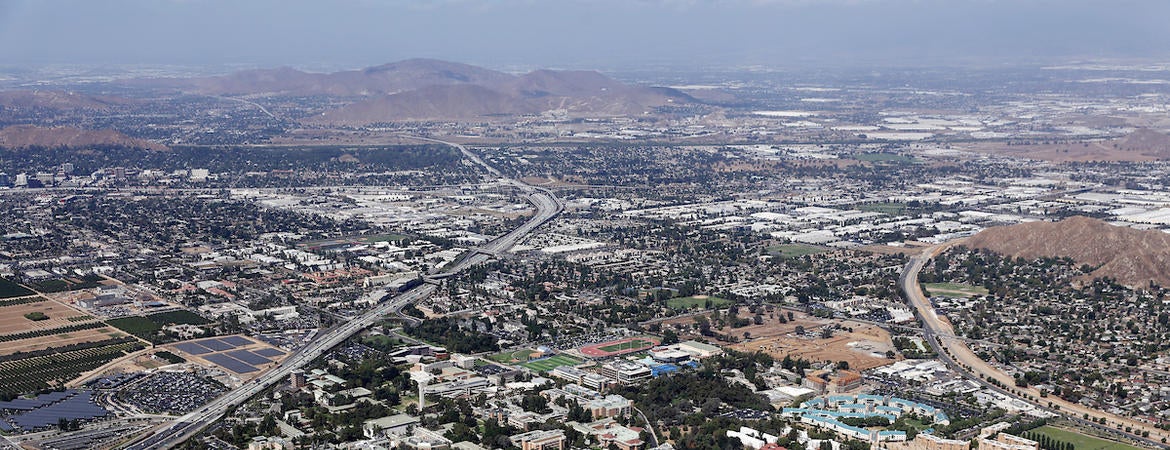
As the effects of pandemic-driven business closures and restrictions steadily diminish, and with California "officially reopened," the economy of the Inland Empire is on a robust near-term growth trajectory, according to an analysis released today by the UC Riverside School of Business Center for Economic Forecasting and Development. While some industries and workers continue to struggle, the region’s strength is especially apparent in job recovery and housing market metrics.
As of May, the latest numbers available, the Inland Empire’s labor market has added back 70% (145,700) of the jobs lost in the early months of 2020. This compares very favorably to the state as a whole (52%), and to other Southern California metros (Los Angeles 40%, San Diego 51%, Orange County 56%). While there is still some distance to go to reach pre-pandemic levels (total nonfarm employment in the region currently sits -4.2% below its February 2020 peak), significant consumer demand should drive hiring over the summer, according to the analysis.
The region’s housing market is also enjoying rapid growth, both historically and relative to other areas of Southern California. Indeed, housing has been the brightest spot in the local economy throughout the pandemic: From the first quarter of 2020 through the first quarter of 2021, the Inland Empire’s median home price surged 18.5% compared to 17.8% in Los Angeles, 15.4% in San Diego, and 12.2% in Orange County. Over the same period, home sales jumped 24.3%, more than in any other metro in Southern California.
Part of this can be traced to the fact that the region continues to be the most affordable and has more room to grow. However, historically low inventories and mortgage interest rates have created an especially heated market.
“The driving pressure here is clear cut – demand for housing has increased markedly but supply has not,” said Taner Osman, Research Manager at the Center for Economic Forecasting and one of the report’s authors. “It’s an intensely competitive period where offers have soared far above asking prices and buyers are waiving inspections and other contingencies to get a leg up.” However, if fears of inflation are realized, mortgage rates are also likely to jump, which could sap some of the momentum from the market, according to Osman.
Key findings:
Industry impacts: Not surprisingly, the largest job losses in the Inland Empire have been concentrated in the Leisure and Hospitality sector with -33,200 fewer workers compared to February 2020 (-18.8%). And although significant pent up consumer demand should drive growth in this and other sectors heavily damaged by the pandemic, businesses are struggling to hire enough workers which could slow recovery.
COVID containment critical: As of mid-June, the 7-day moving average for new daily cases of COVID-19 in the Inland Empire has dropped below 100, an enormous improvement over the 7,000 daily cases occurring early this year. Vaccinations have played a key role and continued reduction of the virus is critical to maintaining the economic recovery.
Rising rent: Asking rents in the Inland Empire grew 3.1% over the past year to $1,487 per-unit per month. Despite the growth, rent in the region is still more affordable than in Los Angeles ($1,974), San Diego ($1,859), and Orange ($1,973) Counties.
Warehouses are hot: As e-commerce spending surged throughout the pandemic, so too did the demand for warehouse space. The vacancy rate among warehouse properties in the Inland Empire fell to 9.7% in the first quarter of 2021 even as 10 million square feet of new space was added to the region’s available stock.
The new Inland Empire Regional Intelligence Report was authored by Osman and Senior Research Associate Brian Vanderplas. The analysis examines how the Inland Empire’s labor market, real estate markets, and other areas of the economy are recovering from the COVID-19 pandemic and their outlook for the remainder of the year. The full analysis.
The UC Riverside School of Business Center for Economic Forecasting and Development is the first major university forecasting center in Inland Southern California. The center is dedicated to economic forecasting and policy research focused on the region, state, and nation. Learn more.



